Ask Anne…
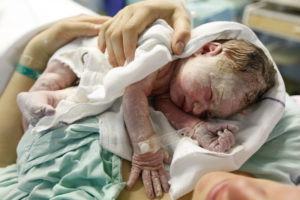 Question: When my baby was born at 38 weeks, I wanted to breastfeed her immediately after birth. I had written into my birth plan that I didn’t want her to be taken away to be washed before I held her, but when she was laid on my chest after birth, she was covered with this weird creamy stuff and the nurse said she needed to bathe her and get the ‘vernix’ off before I held her.
Question: When my baby was born at 38 weeks, I wanted to breastfeed her immediately after birth. I had written into my birth plan that I didn’t want her to be taken away to be washed before I held her, but when she was laid on my chest after birth, she was covered with this weird creamy stuff and the nurse said she needed to bathe her and get the ‘vernix’ off before I held her.
I let her take the baby and clean her up, and she brought her to me a few minutes later, wrapped in a blanket with a little cap on her head. I was able to get her to latch on and nurse, but I wondered if she really needed to be taken away and bathed before I got to nurse her. What the heck is ‘vernix”, and why did they need to wash it off?
Answer: You’re right about the importance of nursing immediately after birth, if possible. It’s been shown that when babies receive colostrum within an hour of birth, it will kick their immune system into high gear and the babies are much healthier. Sometimes the first few minutes after birth are called the “Power Hour” for this reason.
Vernix is is the white creamy waxy stuff that newborn babies have on their skin when they’re born. It starts developing in the womb, to protect the baby’s skin from getting all pruny and wrinkly while they’re floating around in water for 9 months. The baby’s body starts to absorb the vernix during the later stages of pregnancy, so premature babies tend to have more than full term babies.Some babies have lots of vernix when they’re born, sometimes even enough to make them look pale instead of a healthy pink. When I had my 5th baby at home, she had more vernix than any of the previous four. She was full term and weighed nearly 9 lbs. My first comment when I saw her was about how much vernix she had.
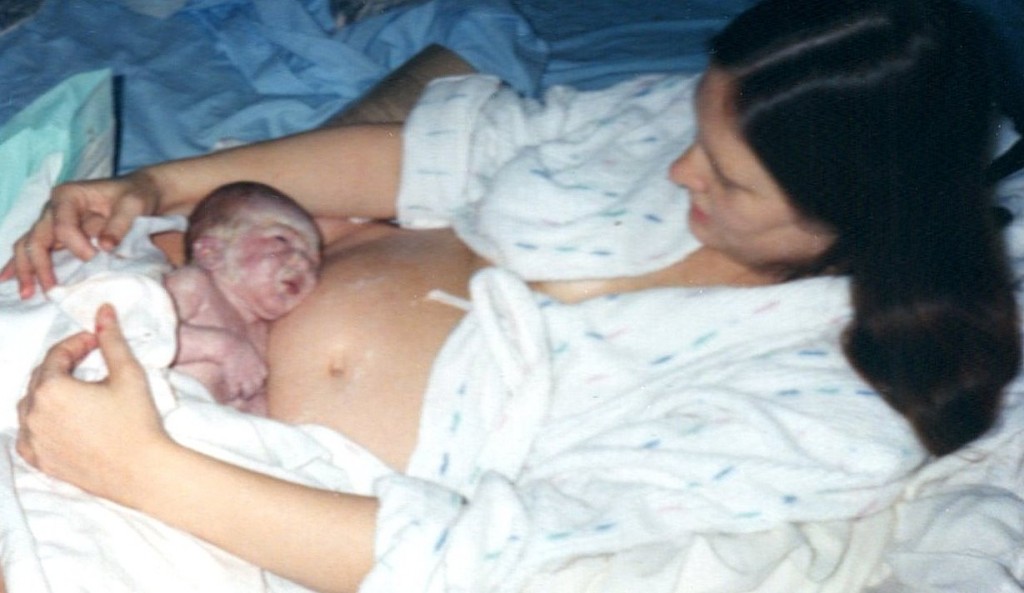 My midwife explained that it was a good idea to rub the vernix in. It’s mother nature’s natural moisturizer, and it rubs in just like cold cream or lotion. The baby’s skin just soaks it right up. If it’s washed off, the skin looks dry and flaky. It just makes more sense to do that than to wipe it off and wash the baby’s delicate skin. My kids helped rub in in, and thought it was very cool.
My midwife explained that it was a good idea to rub the vernix in. It’s mother nature’s natural moisturizer, and it rubs in just like cold cream or lotion. The baby’s skin just soaks it right up. If it’s washed off, the skin looks dry and flaky. It just makes more sense to do that than to wipe it off and wash the baby’s delicate skin. My kids helped rub in in, and thought it was very cool.
Women used to all know how to do things like rub in the vernix, let the cord stop pulsing before cutting it, and massage the perineum to avoid tearing, until they started giving birth in hospitals and the male doctors turned having a baby into a medical procedure. It’s only been in the last few years that babies were given to their moms to hold (and to nurse) immediately after birth. Instead, they were whisked off by nurses who washed them, weighed them, diapered them, put little caps on their heads, took their temp, put drops in their eyes, gave them a vitamin K shot, wrapped them in blankets, and then brought them back to their moms, all cleaned up – and sometimes too tired to nurse well. Some hospitals still routinely do these procedures, but those who are ‘breastfeeding friendly’ are starting to get with the program.
Babies are most alert in the first hour after birth. When all those things are done immediately, it tires them out, and a lot of times they will be too sleepy to nurse well. If your baby is laid right on your chest after birth, vernix and all, it’s natural to stroke her and massage in the vernix. Many nurses want to clean the baby first to get off the vernix, and also to clean off any blood that the baby might have on them. With a natural birth, and little or no tearing, there won’t be much blood on the baby (notice there was none in my pic of Brea, even though she weighed nearly 9 lbs), and if there is, you can always ask the nurse for a warm washcloth to wipe the blood off, but there isn’t any need to wipe off the vernix.
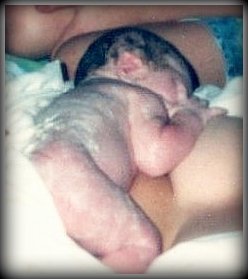 Not only is vernix is a great moisturizer, it also contains anti-infective properties. Vernix has immunological benefits that help protect your newborn baby from infection, and its moisturizing properties help keep her delicate skin from being dry and flaky.
Not only is vernix is a great moisturizer, it also contains anti-infective properties. Vernix has immunological benefits that help protect your newborn baby from infection, and its moisturizing properties help keep her delicate skin from being dry and flaky.
There is another little known fact about vernix. It has a distinctive smell, different and unique with each baby. It’s the sweetest smell in the world, and just like newborn puppy breath, it only lasts a short time. Snuggling and holding your baby close while you breath in her special scent can increase the production of the hormone oxytocin which relaxes you and helps you bond with your baby right from the beginning.
There isn’t any reason to wash the vernix off. I’m glad you got to spend that special time together after her birth – but if there is a next time, you’ll know to just massage it in, and worry about the bath later.
Anne Smith. IBCLC
Breastfeeding Basics
 Breastfeeding Basics
Breastfeeding Basics

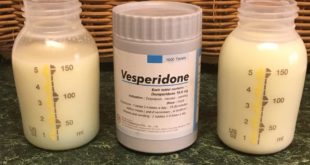

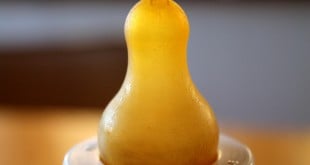

My darling daughter was born 19 years ago covered in vernix. She is studying in London and is suffering from depression. So I took photos of her scan and of the hidden photos of her birth and whatsapped it to tell her how special she is. I chanced upon your page as I looked how to spell vernix….I loved reading your article and have forwarded your page to a new Mom for some encouragement she has a week old. We live in Spain .thank you so much. Melanie x ps I call my daughter my marshmallow girl…..
i have loved the information. thanks
When my second daughter was delivered she was placed right on mom’s chest, as instructed in my birth plan.
My birth plan had explicit instructions not to perform any interventions such as cleaning, poking, probing, injections, etc. We didn’t bath her for a week or two. One of the most profound memories of my life was smelling that vernix. It was absolutely intoxicating. Funny but it didn’t seem to have that affect for her mother. I’m convinced now that the vernix has a undocumented function of Dad bonding. Who knows? I do know that babies need all the bonding they can get, so keep that vernix in place!
I loved reading this. I had a difficult labour and birth first time around that ended with a forceps delivery. Second time around I had a different midwife that knew and dislikes the way hospitals let women birth. I ended up having my almost 9lb boy at home by accident. When I realized he was coming even without a midwife I was confident I could do it and my body knew what to do. He also arrived with a good coating of vernix. He came straight to my chest. Both my babies didn’t have a bath until they were more than a week old and I would just flake the dried blood out of their hair as they nursed. Women need to know these things and I’m glad you’re putting it out there.